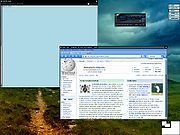
Vtwm
Encyclopedia

X window manager
An X window manager is a window manager which runs on top of the X Window System, a windowing system mainly used on Unix-like systems.Unlike the Mac OS and Microsoft Windows platforms which have historically provided a vendor-controlled, fixed set of ways to control how windows and panes display...
that was developed from the twm
Twm
In computing, twm is the standard window manager for the X Window System, version X11R4 onwards...
codebase. The first release was in 1990, and it is very much an "old school" window manager. It added features like xpm icons, autoraising of windows, and a virtual desktop
Virtual desktop
In computing, a virtual desktop is a term used with respect to user interfaces, usually within the WIMP paradigm, to describe ways in which the size of a computer's desktop environment is expanded beyond the physical limits of the screen's real estate through the use of software, This saves space...
; the latter feature is from where the program takes its name. Later additions include playing sounds in response to window manager events, and Motif
Motif (widget toolkit)
In computing, Motif refers to both a graphical user interface specification and the widget toolkit for building applications that follow that specification under the X Window System on Unix and other POSIX-compliant systems. It emerged in the 1980s as Unix workstations were on the rise, as a...
-style window decorations in place of the "flat," 2D titlebars commonly associated with twm.
Vtwm was one of the first window managers to have an icon manager, a box of click able windows which mapped to the application windows currently on the desktop. Clicking the entry in the icon manager iconizes/deiconizes the associated application. This behavior is common today in taskbar
Taskbar
In computing, a taskbar is a bar displayed on a full edge of a GUI desktop that is used to launch and monitor running applications. Microsoft incorporated a taskbar in Windows 95 and it has been a defining aspect of Microsoft Windows's graphical user interface ever since. Some desktop environments,...
s in many operating systems.
Features
- A stacking window manager
- Written in C
- Uses the xlibXlibXlib is an X Window System protocol client library written in the C programming language. It contains functions for interacting with an X server. These functions allow programmers to write programs without knowing the details of the protocol...
toolkit - opensource and freely available
- No menubar
- Lightweight - Has few dependencies
- Support for multiple desktops
Other features of twm, including shaped window titlebars, are faithfully incorporated into vtwm.
The focus of vtwm is to maintain simplicity and compatibility. It is believed to still work under X Window System
X Window System
The X window system is a computer software system and network protocol that provides a basis for graphical user interfaces and rich input device capability for networked computers...
revision 4, and can be compiled and run with no dependencies beyond the standard X libraries.

